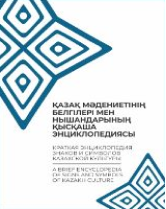
Artistic felting (felt-making)
According to some artisans, felting and even rug making in the traditional environment was seen as a common activity that every woman had to master. Before the advent of factory dyes, craftswomen used only natural dyes, which were extracted from various plants, to dye wool.
The process of making felt was a long and time-consuming process, which was accompanied by magical rituals. According to tradition, felting began with the utterance of a bata by the oldest participant, which was said during a tea party before starting the work of making the felt, for which a team of neighbours and girlfriends of the hostess were gathered. The presence of men or their participation in making felt was considered undesirable. According to some masters, the Kazakhs used to have a special ritual song – tekemet basu.
In the case of small felt making, the plates were rolled by hand while sitting on the ground. A medium-sized piece of felt was usually rolled by several women who sat in a row or made synchronized movements with their feet. Large size felt was tied with ropes and tied to a horse to drag the product.
Unfortunately, there are now only a handful of skilled craftsmen who are familiar with the traditional technology of felting.
Among them: Kulyan Zhangutty, Aues Sagynayeva, Akkumis Kospayeva, Tamara Kapkyzy, Kamash Toleubaeva, Kalekesh Zhusipova, Zhansara Bolegenova and many others.
At the moment in Central Asia and Kazakhstan, felt is one of the most sought-after artistic materials with almost limitless possibilities. It is used to create a wide variety of products in a modern format: panels, clothes, shoes, toys, souvenirs and various accessories and jewellery. The focus of this study, however, is on traditional technology, which needs to be carefully preserved, popularised and passed on to the young.
In 2022, the city of Taraz deservedly had the honour of becoming one of the first cities in Kazakhstan to be included in the World Craft City List. There are 78 officially registered artisans in the city, most of whom are involved in the production of felt goods.
The creative possibilities of felt are also attracting male masters. An example is the work of ethno-designer and artist Kuanysh Urkinbaev. The artist founded his own workshop, “Tekemet-ART”. Today, the workshop produces a wide range of
felt products, which has consistently received awards and certificates confirming the high quality and uniqueness of its products.
The boundless potential of felting was demonstrated at the recently held international festival ” Kиiз.Felt.Keçe.Войлок”. The festival was organised by the Artisans Union of Kazakhstan. This large-scale event brought together all professionals, researchers and the general public. As part of the festival, there was an exhibition of felt works with the poetic title “The Art of Kiyz Basu”, with the installation “Seasons” by one of the world’s best felt artists, Janice Arnold from the United States as the focal point.



